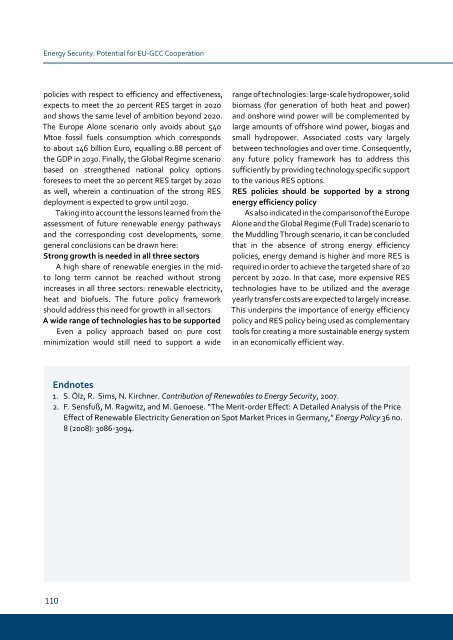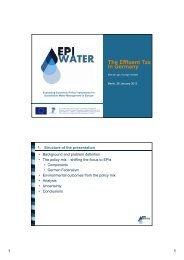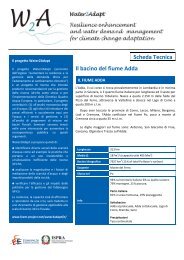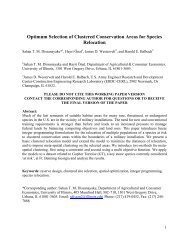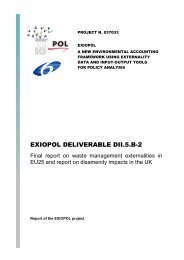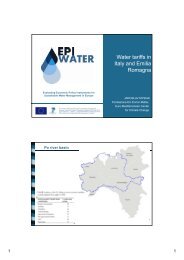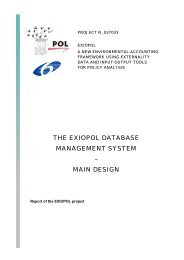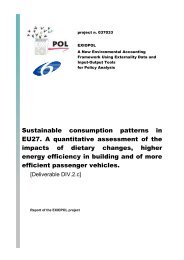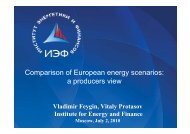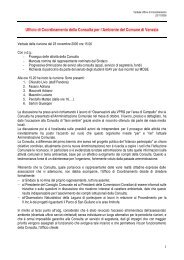Gulf and European Energy Supply Security - Feem-project.net
Gulf and European Energy Supply Security - Feem-project.net
Gulf and European Energy Supply Security - Feem-project.net
Create successful ePaper yourself
Turn your PDF publications into a flip-book with our unique Google optimized e-Paper software.
<strong>Energy</strong> <strong>Security</strong>: Potential for EU-GCC Cooperation<br />
policies with respect to efficiency <strong>and</strong> effectiveness,<br />
expects to meet the 20 percent RES target in 2020<br />
<strong>and</strong> shows the same level of ambition beyond 2020.<br />
The Europe Alone scenario only avoids about 540<br />
Mtoe fossil fuels consumption which corresponds<br />
to about 146 billion Euro, equalling 0.88 percent of<br />
the GDP in 2030. Finally, the Global Regime scenario<br />
based on strengthened national policy options<br />
foresees to meet the 20 percent RES target by 2020<br />
as well, wherein a continuation of the strong RES<br />
deployment is expected to grow until 2030.<br />
Taking into account the lessons learned from the<br />
assessment of future renewable energy pathways<br />
<strong>and</strong> the corresponding cost developments, some<br />
general conclusions can be drawn here:<br />
strong growth is needed in all three sectors<br />
A high share of renewable energies in the mid-<br />
to long term cannot be reached without strong<br />
increases in all three sectors: renewable electricity,<br />
heat <strong>and</strong> biofuels. The future policy framework<br />
should address this need for growth in all sectors.<br />
A wide range of technologies has to be supported<br />
Even a policy approach based on pure cost<br />
minimization would still need to support a wide<br />
110<br />
endnotes<br />
1.<br />
2.<br />
range of technologies: large-scale hydropower, solid<br />
biomass (for generation of both heat <strong>and</strong> power)<br />
<strong>and</strong> onshore wind power will be complemented by<br />
large amounts of offshore wind power, biogas <strong>and</strong><br />
small hydropower. Associated costs vary largely<br />
between technologies <strong>and</strong> over time. Consequently,<br />
any future policy framework has to address this<br />
sufficiently by providing technology specific support<br />
to the various RES options.<br />
Res policies should be supported by a strong<br />
energy efficiency policy<br />
As also indicated in the comparison of the Europe<br />
Alone <strong>and</strong> the Global Regime (Full Trade) scenario to<br />
the Muddling Through scenario, it can be concluded<br />
that in the absence of strong energy efficiency<br />
policies, energy dem<strong>and</strong> is higher <strong>and</strong> more RES is<br />
required in order to achieve the targeted share of 20<br />
percent by 2020. In that case, more expensive RES<br />
technologies have to be utilized <strong>and</strong> the average<br />
yearly transfer costs are expected to largely increase.<br />
This underpins the importance of energy efficiency<br />
policy <strong>and</strong> RES policy being used as complementary<br />
tools for creating a more sustainable energy system<br />
in an economically efficient way.<br />
S. Ölz, R. Sims, N. Kirchner. Contribution of Renewables to <strong>Energy</strong> <strong>Security</strong>, 2007.<br />
F. Sensfuß, M. Ragwitz, <strong>and</strong> M. Genoese. “The Merit-order Effect: A Detailed Analysis of the Price<br />
Effect of Renewable Electricity Generation on Spot Market Prices in Germany,” <strong>Energy</strong> Policy 36 no.<br />
8 (2008): 3086-3094.


